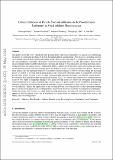| dc.contributor.author | Meier, Christoph | |
| dc.contributor.author | Weissbach, Reimar | |
| dc.contributor.author | Weinberg, Johannes | |
| dc.contributor.author | Wall, Wolfgang A | |
| dc.contributor.author | Hart, A John | |
| dc.date.accessioned | 2021-10-27T20:09:48Z | |
| dc.date.available | 2021-10-27T20:09:48Z | |
| dc.date.issued | 2019 | |
| dc.identifier.uri | https://hdl.handle.net/1721.1/134908 | |
| dc.description.abstract | The quality of powder layers, specifically their packing density and surface uniformity, is a critical factor influencing the quality of components produced by powder bed metal additive manufacturing (AM) processes, including selective laser melting, electron beam melting and binder jetting. The present work employs a computational model to study the critical influence of powder cohesiveness on the powder recoating process in AM. The model is based on the discrete element method (DEM) with particle-to-particle and particle-to-wall interactions involving frictional contact, rolling resistance and cohesive forces. Quantitative metrics, namely the spatial mean values and standard deviations of the packing fraction and surface profile field, are defined in order to evaluate powder layer quality. Based on these metrics, the size-dependent behavior of exemplary plasma-atomized Ti–6Al–4V powders during the recoating process is studied. It is found that decreased particle size (increased cohesiveness) leads to considerably decreased powder layer quality in terms of low, strongly varying packing fractions and highly non-uniform surface profiles. For relatively fine-grained powders (median particle diameter 17 μm), it is shown that cohesive forces dominate gravity forces by two orders of magnitude leading to low quality powder layers not suitable for subsequent laser melting without additional layer/surface finishing steps. Besides particle-to-particle adhesion, this contribution quantifies the influence of mechanical powder material properties, nominal layer thickness, blade velocity, as well as particle-to-wall adhesion. Finally, the implications of the resulting powder layer characteristics on the subsequent melting process are discussed and practical recommendations are given for the choice of powder recoating process parameters. While the present study focuses on a rigid blade recoating mechanism, the proposed simulation framework can be applied to systems using alternative recoating tools such as soft blades, rakes or rotating rollers. | |
| dc.language.iso | en | |
| dc.publisher | Elsevier BV | |
| dc.relation.isversionof | 10.1016/J.JMATPROTEC.2018.10.037 | |
| dc.rights | Creative Commons Attribution-NonCommercial-NoDerivs License | |
| dc.rights.uri | http://creativecommons.org/licenses/by-nc-nd/4.0/ | |
| dc.source | arXiv | |
| dc.title | Critical influences of particle size and adhesion on the powder layer uniformity in metal additive manufacturing | |
| dc.type | Article | |
| dc.contributor.department | Massachusetts Institute of Technology. Department of Mechanical Engineering | |
| dc.contributor.department | Lincoln Laboratory | |
| dc.relation.journal | Journal of Materials Processing Technology | |
| dc.eprint.version | Original manuscript | |
| dc.type.uri | http://purl.org/eprint/type/JournalArticle | |
| eprint.status | http://purl.org/eprint/status/NonPeerReviewed | |
| dc.date.updated | 2020-07-17T18:58:34Z | |
| dspace.orderedauthors | Meier, C; Weissbach, R; Weinberg, J; Wall, WA; Hart, AJ | |
| dspace.date.submission | 2020-07-17T18:58:37Z | |
| mit.journal.volume | 266 | |
| mit.license | PUBLISHER_CC | |
| mit.metadata.status | Authority Work and Publication Information Needed | |
